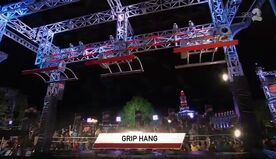No edit summary |
|||
| Line 2: | Line 2: | ||
|name = Delta Bridge |
|name = Delta Bridge |
||
|image = Deltabridge16.png |
|image = Deltabridge16.png |
||
| − | |caption = [[Kobayashi Shinji]] on the Delta Bridge, |
+ | |caption = [[Kobayashi Shinji]] on the Delta Bridge, [[SASUKE 16]] |
|s_stage = [[Second Stage]] |
|s_stage = [[Second Stage]] |
||
|s_first = [[SASUKE 16]] |
|s_first = [[SASUKE 16]] |
||
| Line 10: | Line 10: | ||
|s_clear = [[SASUKE 16]], [[Nagasawa Hidenori]] |
|s_clear = [[SASUKE 16]], [[Nagasawa Hidenori]] |
||
|g4_name = Grip Hang}} |
|g4_name = Grip Hang}} |
||
| − | |||
The '''Delta Bridge''' (デルタブリッジ), called the ''Grip Hang'' in English broadcast, was an obstacle that was introduced in [[SASUKE 16]]'s Second Stage to replace the [[Balance Tank]]. |
The '''Delta Bridge''' (デルタブリッジ), called the ''Grip Hang'' in English broadcast, was an obstacle that was introduced in [[SASUKE 16]]'s Second Stage to replace the [[Balance Tank]]. |
||
Although labelled as a bridge obstacle, the obstacle required no balance. Instead, the competitor had to hang onto two outward-facing ledges and cross a small gap. Competitors usually crossed the gap by alternating arms and leaping to the landing mat below. |
Although labelled as a bridge obstacle, the obstacle required no balance. Instead, the competitor had to hang onto two outward-facing ledges and cross a small gap. Competitors usually crossed the gap by alternating arms and leaping to the landing mat below. |
||
| − | This functioned more as a time waster. Only [[Izumiyama Yūta]] failed it; he was low on time and tried rushing through the obstacle. It only lasted one tournament, and the [[Balance Tank]] was brought back in its place for [[SASUKE 17]]. |
+ | This obstacle functioned more as a time waster. Only [[Izumiyama Yūta]] failed it; he was low on time and tried rushing through the obstacle. It only lasted one tournament, and the [[Balance Tank]] was brought back in its place for [[SASUKE 17]]. |
The function of the obstacle became similar to the [[Unstable Bridge]], which would appear as the fourth obstacle in [[SASUKE 23]]'s Second Stage, and then moved to the third obstacle from [[SASUKE 24]] to [[SASUKE 30]], directly following any variant of the [[Salmon Ladder]]. |
The function of the obstacle became similar to the [[Unstable Bridge]], which would appear as the fourth obstacle in [[SASUKE 23]]'s Second Stage, and then moved to the third obstacle from [[SASUKE 24]] to [[SASUKE 30]], directly following any variant of the [[Salmon Ladder]]. |
||
Revision as of 00:41, 6 February 2018
The Delta Bridge (デルタブリッジ), called the Grip Hang in English broadcast, was an obstacle that was introduced in SASUKE 16's Second Stage to replace the Balance Tank.
Although labelled as a bridge obstacle, the obstacle required no balance. Instead, the competitor had to hang onto two outward-facing ledges and cross a small gap. Competitors usually crossed the gap by alternating arms and leaping to the landing mat below.
This obstacle functioned more as a time waster. Only Izumiyama Yūta failed it; he was low on time and tried rushing through the obstacle. It only lasted one tournament, and the Balance Tank was brought back in its place for SASUKE 17.
The function of the obstacle became similar to the Unstable Bridge, which would appear as the fourth obstacle in SASUKE 23's Second Stage, and then moved to the third obstacle from SASUKE 24 to SASUKE 30, directly following any variant of the Salmon Ladder.
Etymology
The name of this obstacle derived from Greek uppercase letter "Δ" (delta), with the obstacle being similar to a triangle upon frontal view.
American Ninja Warrior Appearance

American Ninja Warrior 5's Grip Hang in Denver
The Delta Bridge (called as the Grip Hang) appeared as the fifth obstacle on American Ninja Warrior 5 in Denver.
However, unlike in SASUKE 16, there were three sets of two outward-facing ledges instead of one set, with a gap between each ledges.
After the reach the end of one set, competitors must swing and gain momentum to grab the next set of ledges.
The obstacle eliminated several competitors, but almost half of the number of competitors could complete the obstacle. Later, 48 competitors could complete the Denver qualifiers course and advanced to Denver finals.
During Denver finals, the gap between each set of ledges was increased by a few inches. As the result, some competitors failed there.
Competitors' Success Rate
- All results based on the TBS broadcast and external information found
| SASUKE | Clears | Attempts | Percentage |
|---|---|---|---|
| 16 | 15 | 16 | 93.75% |
| Total | 15 | 16 | 93.75% |
